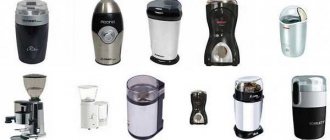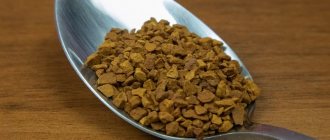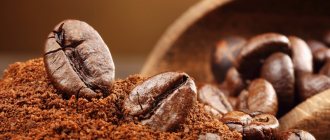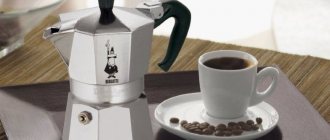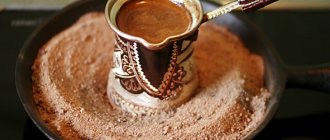Can I use a blender?
The design of a blender is in many ways similar to a blade coffee grinder. The main difference is the location of the knives at a higher level. Therefore, during operation, some of the grains become clogged under them. You have to periodically pause the process, stir the mixture or shake the bowl so that the stuck grains begin to move again. Accordingly, the procedure causes certain difficulties.
You can use the blender as a coffee grinder if you plan to brew the drink in a Turkish coffee pot.
It will not be possible to grind coffee beans for a coffee maker, since this brewing method requires smaller fractions.
Preparing the device for grinding
A blender is not the best grinder for coffee beans. This method of grinding requires some preparation. Before you start grinding coffee, you need to do the following:
- Make sure there is a cover. If you carry out the process without this detail, the grains will scatter throughout the kitchen. After grinding is completed, you will have to spend a lot of time cleaning.
- Count the number of knives with which the unit is equipped . Only double knives with at least four cutting blades are suitable for grinding. If they are single, and there are only two blades, the desired result will not be achieved. Even if the motor is very powerful, the maximum that will be obtained is a coarse grind suitable for a French press.
- Wash and dry all parts of the device. Various products are ground in a blender. It is extremely important to ensure that there are no food residues or foreign odors before use. The presence of moisture during grinding is unacceptable.
Manual grinding methods
While automatic and semi-automatic methods speed up the process, manual methods also work at home, but take longer.
Be sure to read: Cupping coffee - what is it?
What hand tools are there:
- hammer;
- rolling pin;
- mortar and pestle.
As for manual methods, they require more concentration and caution.
Hammer
The first thing we prepare is a metal hammer and a board. If you don't have a heavy hammer, use a chop mallet. For safety and to prevent the grinding from scattering all over the kitchen, we place all the grains in a bag: we use a special bag or paper folded several times. The denser the polyethylene, the better the grinding will be.
What we do next:
- put the coffee in the bag and close it;
- distribute the coffee into the bag - it lies on the board;
- hit with a hammer with short strokes.
To ensure that the grains are crushed evenly, shake them periodically in the bag. The result is a medium or coarse grind. Using a hammer you can get a lot of product, but not the best quality.
rolling pin
A similar method for grinding grains is using a rolling pin. Place the grains in a bag or paper folded several times. We place the package on a board, and then press the contents using a rolling pin. To crush the product, it is necessary to carry out one action several times. The method is similar to rolling out dough.
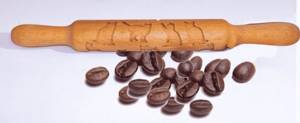
The biggest drawback is that the grind will always be coarse. The result will be average-tasting coffee without a strong aroma.
Mortar and pestle
The last method for crushing coffee beans at home is to use a mortar and pestle. Typically, a mortar is used to prepare spices and grind them into dust. Coffee can also be interrupted, but in very small quantities. The resulting product will be unevenly beaten: uniformity will not be achieved.
Stupas also vary in material and volume. The stronger the material, the better the coffee will be. The best option is a stone mortar. First we crush all the grains, then we try to grind them to the finest powder.
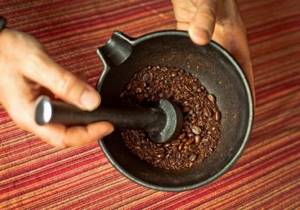
Using a heavy mortar you can achieve a fine grind. It makes a delicious, homemade espresso. The disadvantages of the method include the labor intensity of the process and the time it takes to complete it. Of all the methods, the pestle method takes the longest.
Differences between submersible and stationary
There are only two main types of blenders: stationary and immersion. Both options have a number of characteristic features, advantages and disadvantages that should be taken into account during operation.
Submersible
Grinding in a submersible device causes certain difficulties. To grind coffee in such a blender, you need to select a container with a closing lid in advance. Only in this case, part of the powder will not spill out.
When using this grinding device, you will have to periodically pause the process, remove the moving part of the structure and remove small particles stuck in it.
Stationary
It is quite possible to grind coffee in a stationary device of compact size. It will be difficult to grind grains in a large device. They will simply scatter throughout the bowl. Accordingly, grinding will take a lot of time.
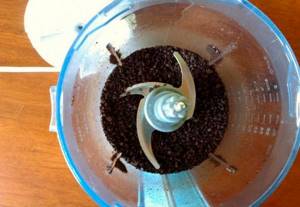
The stationary unit has a great advantage. It is equipped with a lid that prevents the resulting fractions from spilling. In addition, it is possible to use a pulse mode. Thanks to this, the operation of the system is periodically suspended, which means there will be time to shake the bowl and move the grains closer to the knives.
Stationary device
Getting ready for work
If you had to grind coffee in a blender, use a stationary device with a small or narrow bowl. If the distance between the bottom, walls and knives is more than 5 millimeters, the grains will rarely fall under them and therefore will not be crushed.
Wash and dry all parts of the device. There should be no food residues or drops of water - this will spoil the taste and smell of the drink. Be sure to cover the bowl while working, otherwise the coffee beans will scatter throughout the kitchen.
Interesting! Which coffee beans are best for a coffee machine?
Check the quality of the knives . To properly grind coffee, choose double ones with four blades. If there are fewer, you won't even get a coarse grind.
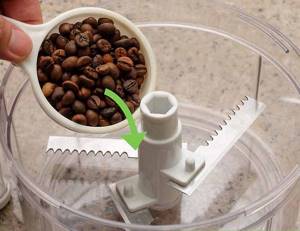
Step-by-step instruction
Grinding grains is possible only if you follow the rules:
- select the lowest power;
- pour 50 grams of grains;
- turn on the device for a minute, turn it off and stir the coffee mass;
- Allow the device to cool for 1-2 minutes and repeat the previous step.
It is better to use pulse mode. If the device is operated for more than 1 minute, it will begin to heat up. Because of this, the drink will acquire an unpleasant burnt taste.
The last step is to wash all parts of the device to eliminate the smell. With this grinder you will get large particles. If you need a fine powder, place the coffee mixture in a cloth or plastic bag and work it over with a rolling pin or hammer.
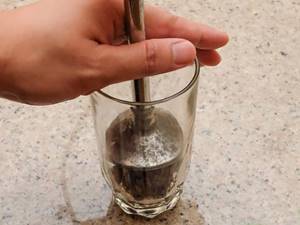
Disadvantages of grinding in a blender
In principle, it is possible to grind coffee beans with a blender, but this method has a number of disadvantages. Among them are the following:
- When grinding grains regularly, the knives quickly become deformed. Additional funds will be required to replace them.
- When using a stationary device, the bowl may be damaged. The grains scratch the walls and microcracks appear. In addition, the container absorbs coffee aroma. This will affect the quality of other products crushed in the device.
- There is a risk of spoiling the grains. When grinding quickly, coffee overheats and acquires a burnt taste and aroma.
You should use a blender instead of a coffee grinder only in exceptional cases. It is strongly not recommended to systematically resort to such manipulations.
Grinding in a stationary device
If you have a stationary device with a bowl, it is advisable that it be compact in size. In a large container, the grains will be very far from the center and it is unlikely to be possible to grind them. Pour the coffee into the container and turn on the device. Be sure to cover the container with a lid so that the processed mass does not fly out of the bowl.
During operation, use the pulse mode to be able to shake the product. Larger parts should be periodically poured closer to the knives to ensure uniform grinding of all grains. Thus, turning on the device several times, grind this product as much as you can.
How else can you grind coffee?
There are a number of alternative options for grinding coffee beans:
- Mechanical mill. The device is designed for grinding herbs and spices. Sometimes it can be used to grind coffee. True, it will not be possible to obtain small fractions in this way.
- Meat grinder. Electrical and manual devices can be used. You should use knives that allow you to chop the product as finely as possible.
- Rolling pin. In order to obtain small fractions, the grains should be placed on a cloth and wrapped. Grinding is done by applying pressure with a rolling pin. True, this requires some effort.
- Hammer . It is used in a similar way to a rolling pin.
It is best to grind coffee in a coffee grinder, but you don’t always have one on hand. In such situations, a blender will come to the rescue. This kitchen unit is also capable of grinding coffee beans. The main thing is to avoid overheating during its operation. Otherwise, all your efforts will be in vain.
How to grind coffee without a coffee grinder
Coffee grinders quickly gave way to specialty coffee machines. The need for them has decreased, and, as a result, they are increasingly rare to find in stores. Moreover, in the modern world, people are accustomed to buying only the necessary equipment - it does not take up extra space and does not lie idle in the kitchen.

Not having a coffee grinder is not a reason to buy only the powder product or pay extra to have your beans ground at a coffee shop. There are alternative options for how to detail them:
- blender;
- meat grinder;
- spice mill.
It is important to remember that it is necessary to grind grains while adhering to all safety rules. The whole process must be thoughtful and with minimal risks, otherwise it is better to buy an already ground product.
Blender
Among all household utensils, a blender is the most reliable assistant. It allows you to grind even the hardest products. It is powerful, especially modern models. For example, modern food processors have a small coffee grinder: it is usually of medium power, but does the job well.
Another option is a chopper attachment. It is usually used to grind cereals into flour. The attachment functions as a coffee grinder, but it is also not very powerful. Before using any attachment, you must read the instructions: if there are direct warnings, you should not use the coffee attachment.
Simple instructions on how to grind coffee in a blender:
- Pour no more than 100 g of grains into a small bowl.
- Next, turn on the blender, but only for a few seconds - you need to see how it copes with the task. We turn on the grinding at intervals, several times.
- To ensure uniform grinding, remove the bowl periodically and shake it.
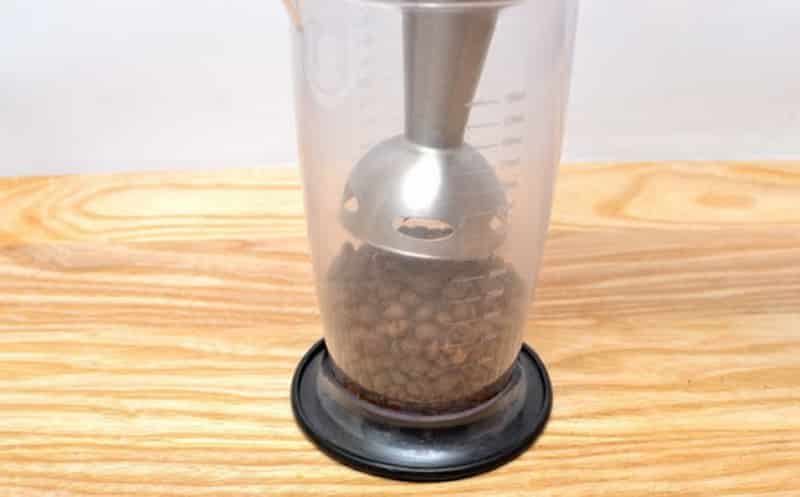
Shredders, especially small ones, should not be turned on for a long period of time. If the blades of the attachment overheat, they will affect the operation of the blender. Solid products themselves are a load for the unit.
Another option, if there is no special grinder attachment: try using a submersible attachment. It is more difficult to work with because the top of the blender will be open - so you need to ensure your safety. Submersible nozzles do not always have high power, so the grains are not always completely crushed.
Be sure to read: Recipes for making Turkish coffee
How to crush grains: pour the product into a special glass, then immerse the nozzle and turn it on at low speed, as carefully as possible. The total operating time is no more than 2-3 seconds, then let the nozzle rest. To prevent the contents from flying out of the bowl, it should be covered from above if possible.
A high-power stationary blender functions as a coffee grinder. It is also turned on at intervals of 2-3 seconds. The main advantage of powerful devices: they make the grind as fine as possible. Additionally, the container is turned off and shaken. The result is medium-ground grounds, but in large volumes. At the end, the bowl must be washed thoroughly - the best option is warm water with soda. Only a soda solution will get rid of the characteristic aroma.
Meat grinder
A more time-consuming method is to grind the coffee using a grinder. An alternative suitable for grinding grains safely. There are 2 types of meat grinders - electric and mechanical. The main disadvantage of a meat grinder as a substitute for a coffee grinder: you won’t be able to get a fine grind.
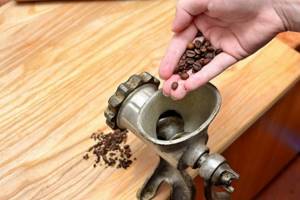
First of all, the meat grinder must be thoroughly washed, especially inside. Then all parts must be dried. The first grind will be coarse, and often you will have to grind it again. The finest grinding is obtained only after several passes through a meat grinder. Afterwards we also thoroughly wash all the parts and dry everything well.
Spice mill
The main function of the mill is to grind various spices. Devices have different power, structure, and operating features. The mill is suitable for working with a small amount of grains or, alternatively, you will have to do the same process several times.
The mill can grind enough beans for 1 cup of coffee at a time. The device has a similar operating principle as a meat grinder - to get a fine grind, you will have to repeat one process several times.
The oldest mills are made of wood - the material absorbs odors well. It is better not to grind coffee in a wooden appliance, because it will have an unpleasant aroma. After coffee, the wood will also be difficult to clean - there are too many difficulties for minimal results.
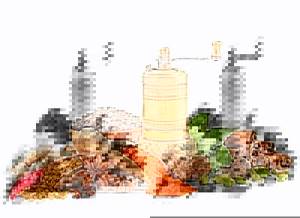
Other disadvantages of the mill, even if it is made of more durable material: there is a high probability of overheating - which is dangerous both for the unit and for humans; cutting parts quickly fail - the device is not intended for hard grains. Using the mill as a coffee grinder, its owner shortens the service life of the device. After the procedure, an unpleasant and pungent odor remains - it is the most difficult to get rid of.
